Great Horned Owlets In Their Nest In Thickson’s Woods
Bob and I had not gone out to Thickson’s Woods Nature Reserve, in Ontario, for about 5 weeks in the spring of 2013. Nor had we heard if the babies had hatched, so a visit was in order to check on the status of things. What a thrill when we sighted two Great Horned Owlets in their nest.
At first, Bob and I were only able to see a vague outline of the mother owl. We thought perhaps she was still sitting on her eggs although that seemed unlikely. We had first seen the female stationed on the nest in late February, and it was now the first week of April. Great Horned Owls usually incubate their eggs for between 28-37 days, so the numbers did not add up.
The female Great Horned Owl is responsible for incubating the clutch of eggs, seldom moving from the nest once the eggs are laid. A clutch usually consists of 2 eggs, but there can be up to 5, even 6, eggs under perfect environmental conditions. Great Horned Owls usually breed together one year after another, and normally mate for life.
I can only imagine how cold it would be sitting in the top of a very tall pine tree. That afternoon, there was a gusty southwest wind blowing, but the air was still very chilly. Mother Owl protected her chick by using her body as a windbreak against the cold draft.
We had a dandy view of the female’s tail. The dark brown bars really stand out against the white feathers. Bob and I couldn’t figure out what the large mass of white was, below the female’s tail, until the huge clump of fluffy white stuff began to move.
The next thing you know, a downy head popped up above the edge of the nest, and two huge eyes peered straight down at us. It was confirmed! At least one chick in the owl’s brood had hatched.
Another bird watcher who happened by told us that a day earlier, the chick had hopped up onto the edge of the nest. The alarmed mother owl scooped it back to safety with her outstretched wing.
Although the nest is massive in our opinion, there was barely room for the female to move about. The adult pair of Great Horned Owls are making good use of a nest abandoned by some other large bird, or perhaps it’s an old squirrel’s dray. To make it more comfortable, the pair may have lined the nest with feathers.
Brooding is a full-time job until the offspring are about 2 weeks old, and this female was not offering to stray from the nest. She relies on the male to bring food for herself and her brood, and she may even be afforded a very brief respite from duty.
Bob and I spied the male owl perched high on a tree on the other side of the woods. He is usually found sitting in one of a few particular trees that border the woodlot, but always within sight of the nest. He kept a watchful eye on every movement in the nest and on the ground.
With the afternoon waning, there was increased activity in the owl’s nest. All of a sudden, a second downy head popped into view, much to our delight. No wonder the female was so cramped for space. We suspected that nap time was over, and the chicks were looking for something to eat.
As if to confirm our suspicions, one of the owlets opened its beak widely and appeared to be manipulating some sort of rodent. The adult owls must maintain some sort of stash in the nest, to hold the owls over between fresh deliveries of prey.
As you see in our video, the owl chick is attempting to ingest some sort of small mammal.
Under the warm rays of the early spring sunshine, the chicks bided their time, all the while climbing over one another, flexing their wings, and taking care of business.
From our position in the woods, which was a great distance from the nest tree, it was very difficult to discern what exactly we were looking at through the camera lens. Point in fact…here we have the back end of one of the owlets perched precariously on the edge of the nest. All I could see through my lens was a huge pile of downy white feathers.
It turns out that the baby was preparing to defecate onto the ground way below…an early lesson in good housekeeping.
One of the Great Horned Owlets peeked down at us through the screen of pine needles, and I felt that the joke was on us. It is surprising how large the beak is at such a tender age, and already we can see the coloration of the eye disks beginning to fill in.
This pair of Great Horned Owls has carefully selected its nesting site within an ideal habitat. Thickson’s Woods is surrounded by marshland and meadows that are home to a variety of suitable prey.
Point in fact, this rabbit that was hunkered down in the shadow of a log, hoping to elude detection by the keen eye of the male Great Horned Owl. Bob and I have also seen chipmunks and squirrels within Thickson’s Woods.
The male remained on his perch and made no move to hunt prey while we were in the woods. Great Horned Owls hunt mostly at night or at dusk taking prey as large as skunks and even the occasional porcupine.
And so it was that we left the woods, knowing that the Great Horned Owlets were in excellent care. Perhaps the next group of bird watchers to arrive on the scene got to see the father owl fly in with a catch. For us, maybe next time…
Frame To Frame – Bob and Jean


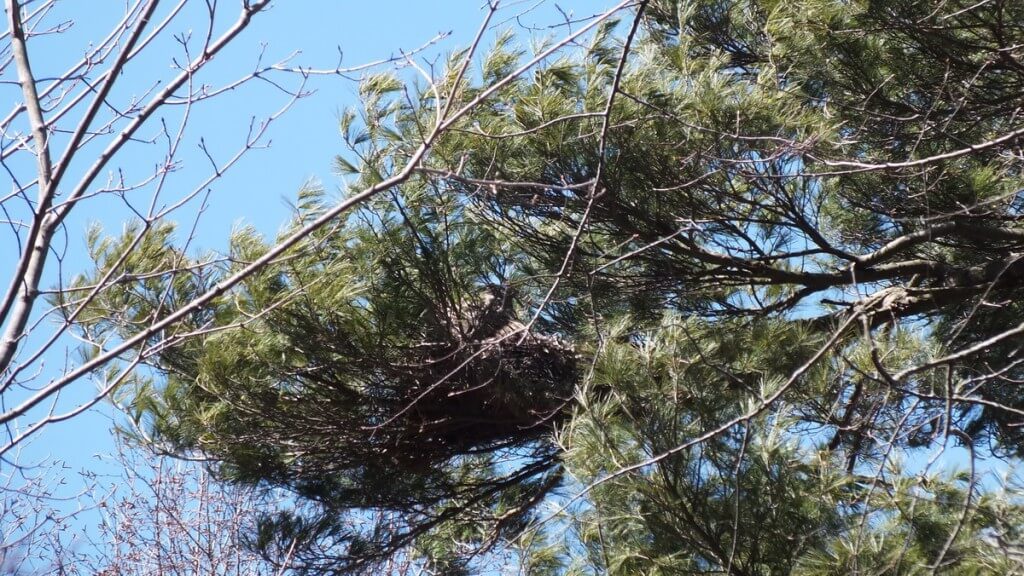
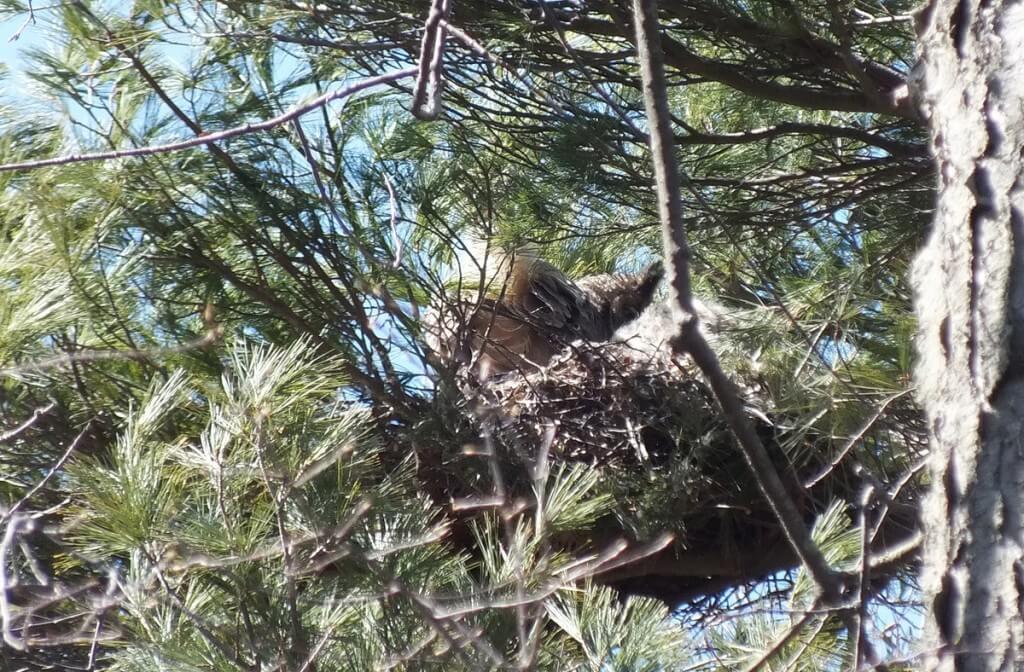
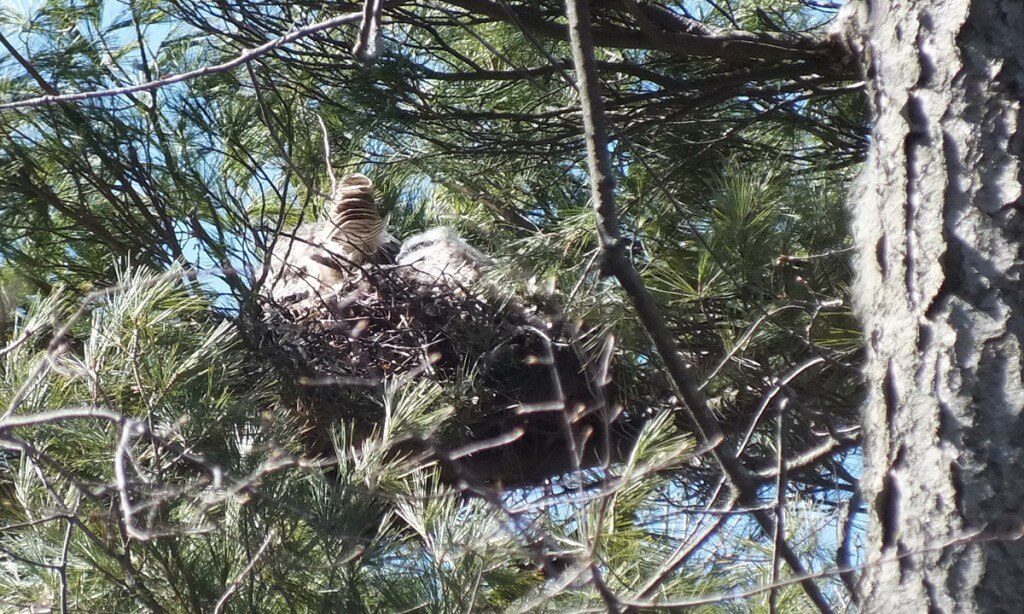
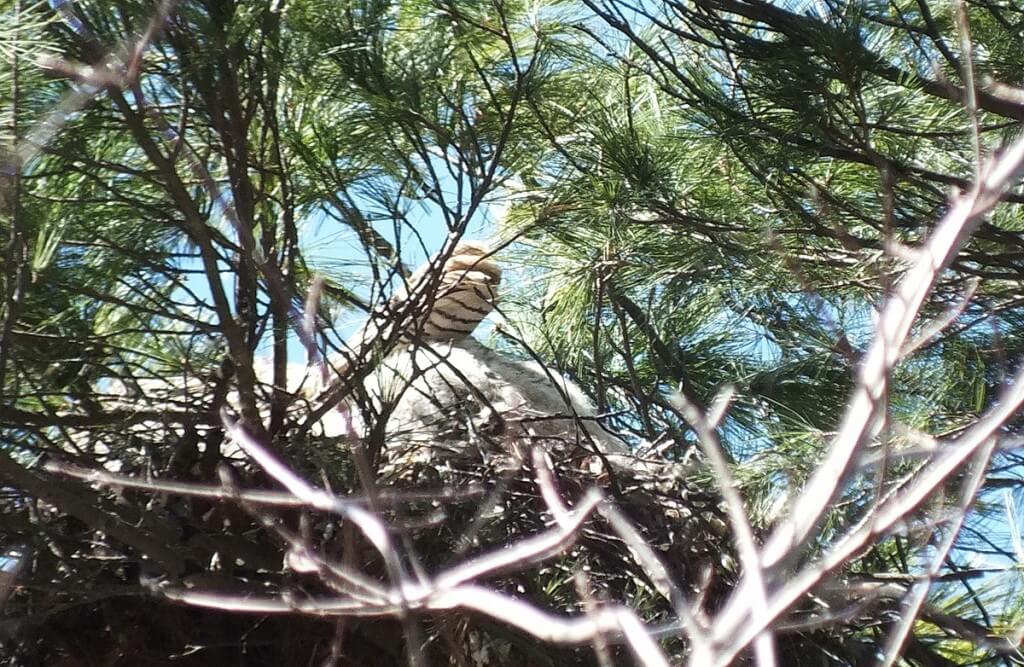
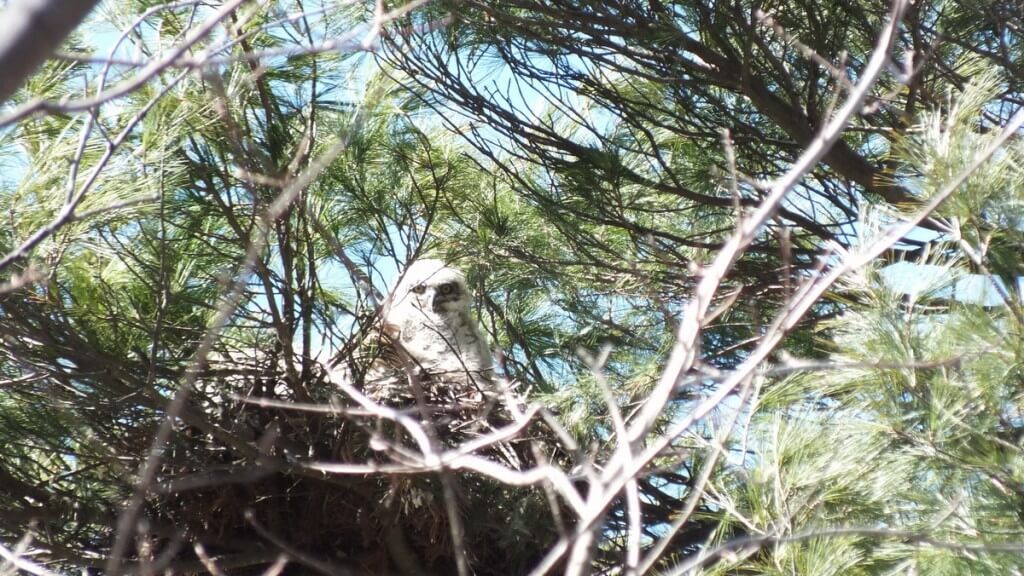
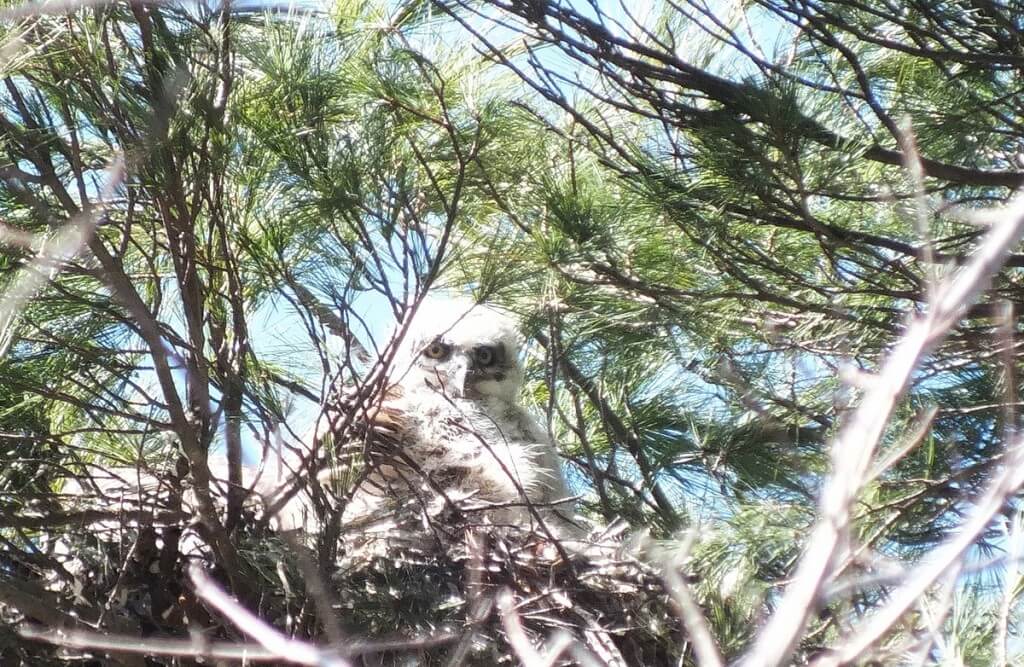
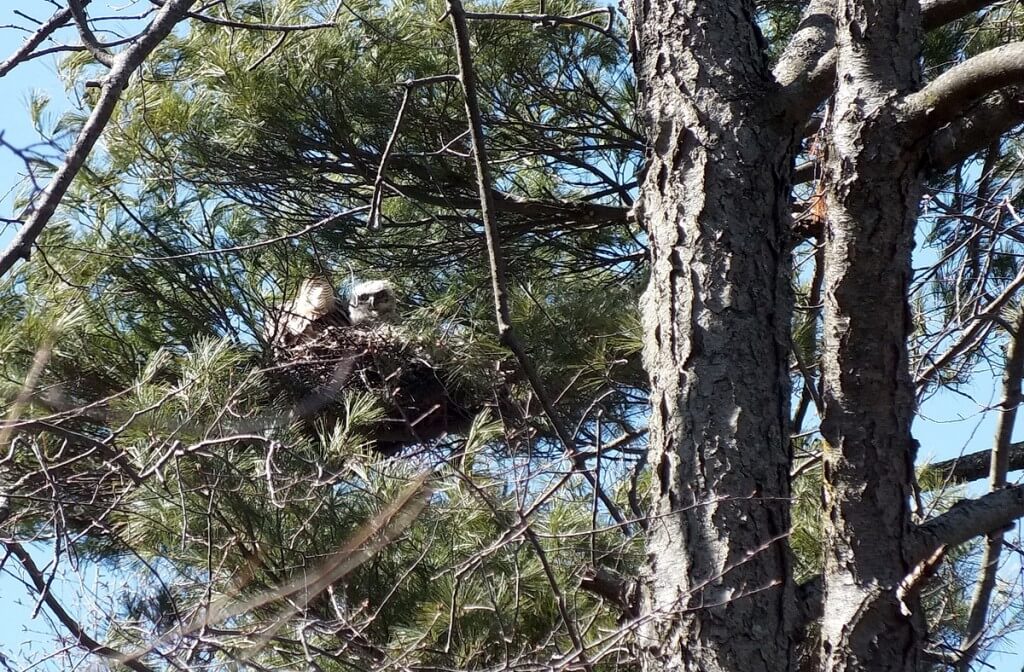
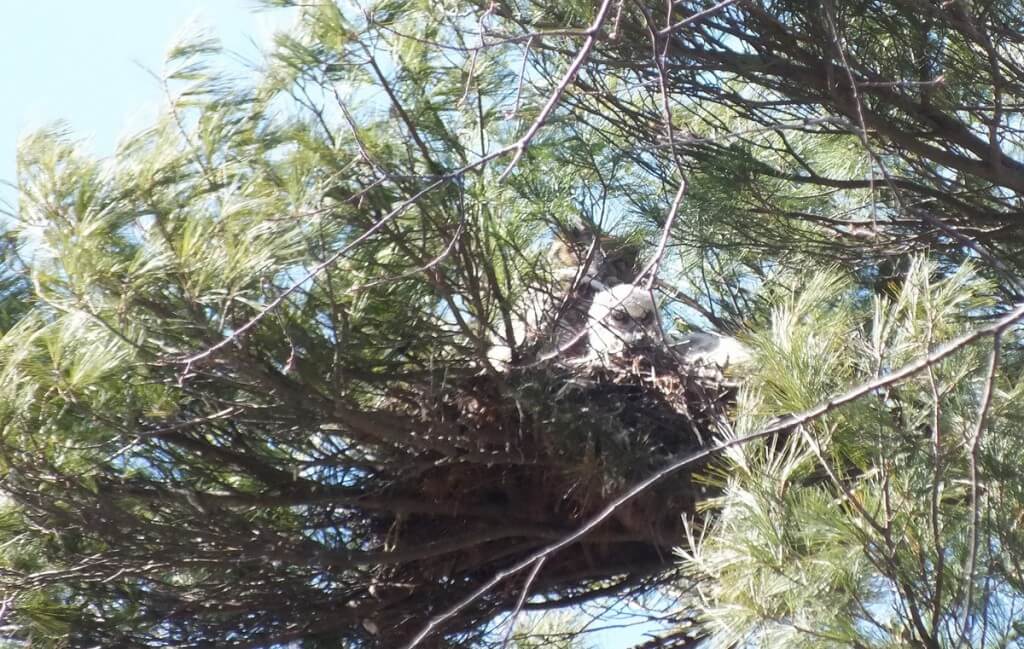




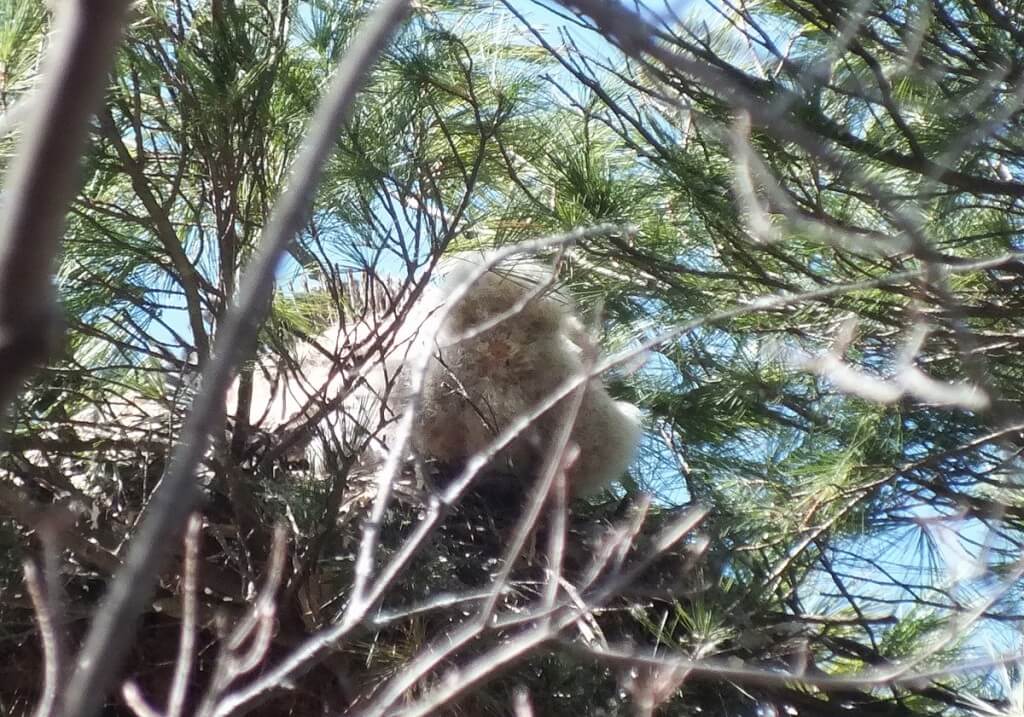
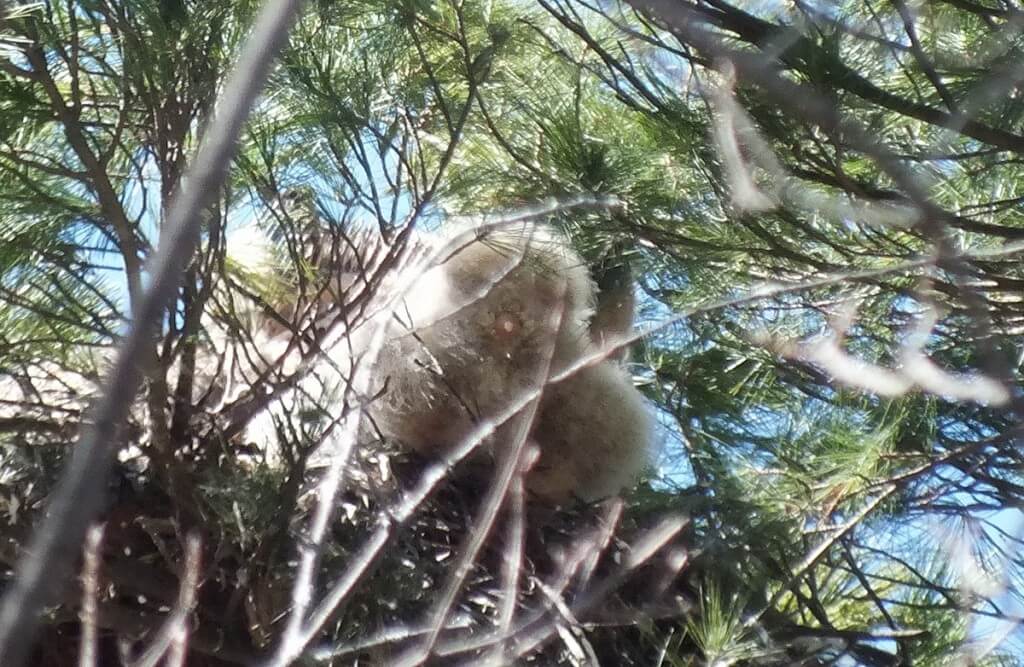
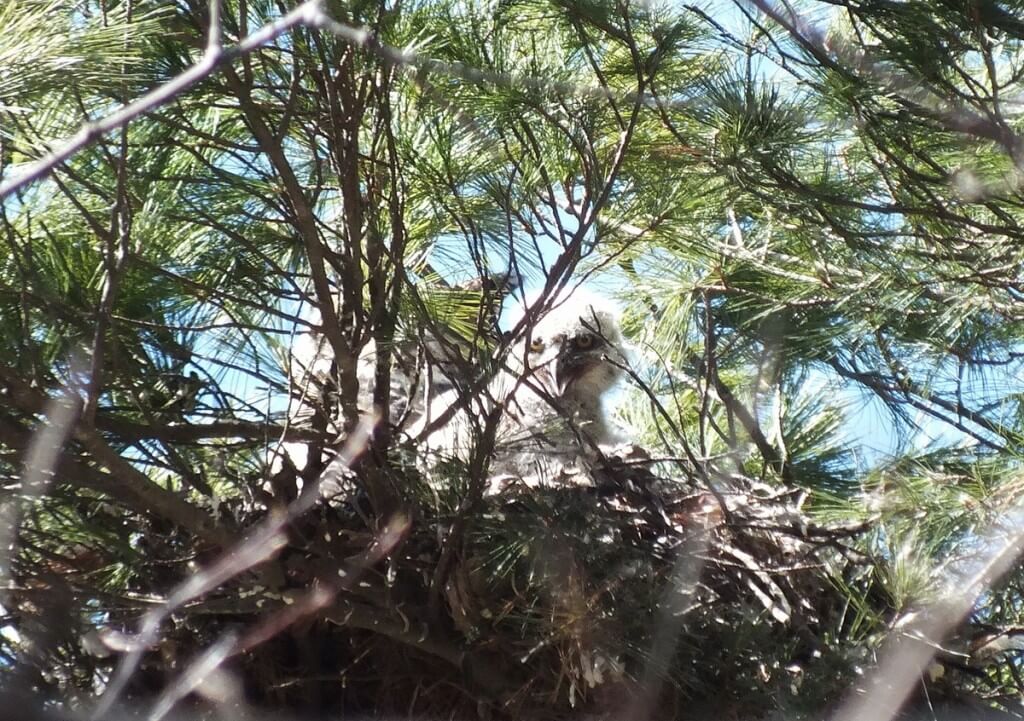
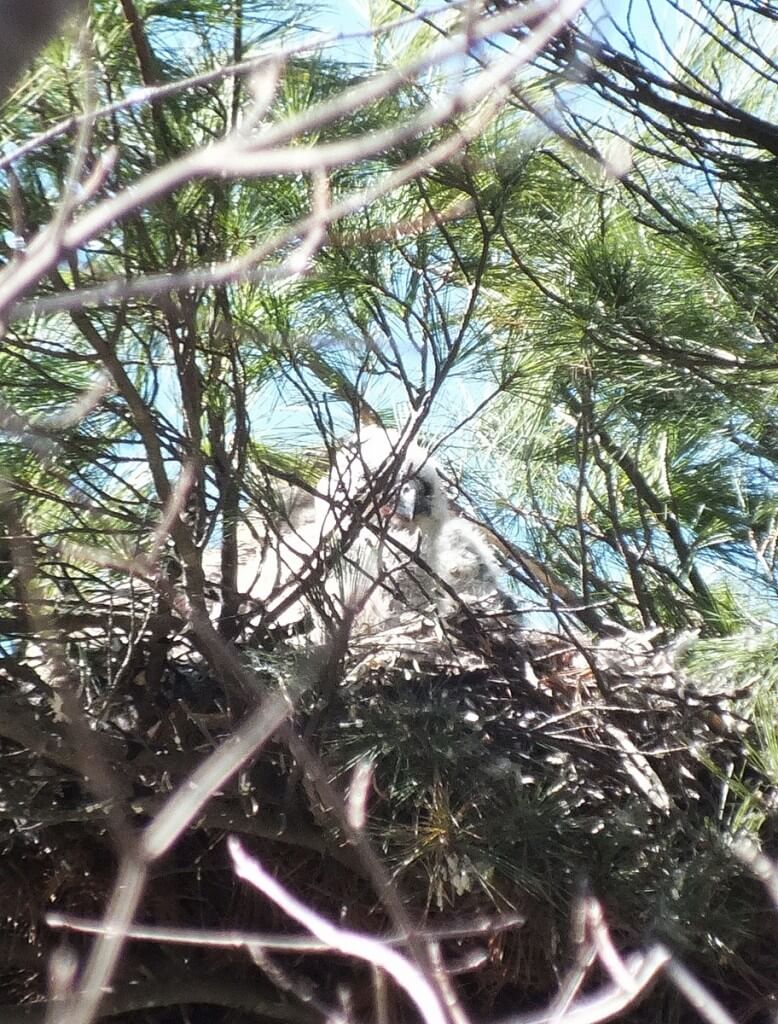
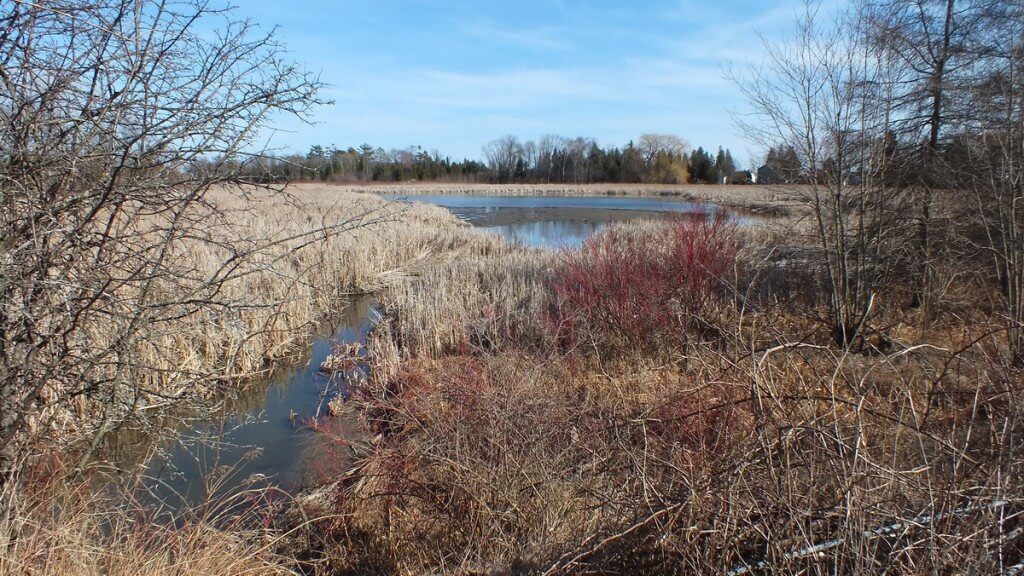
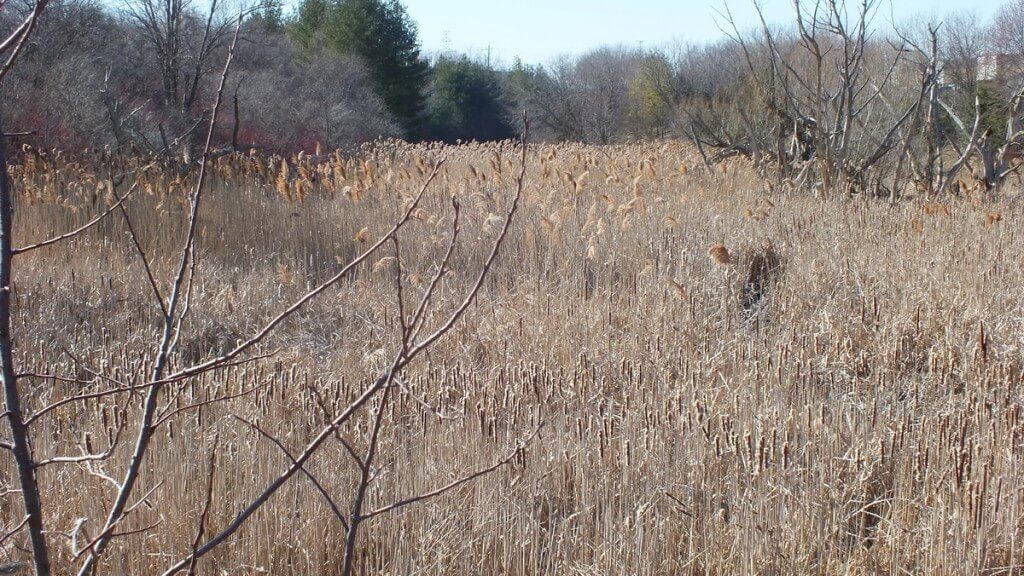
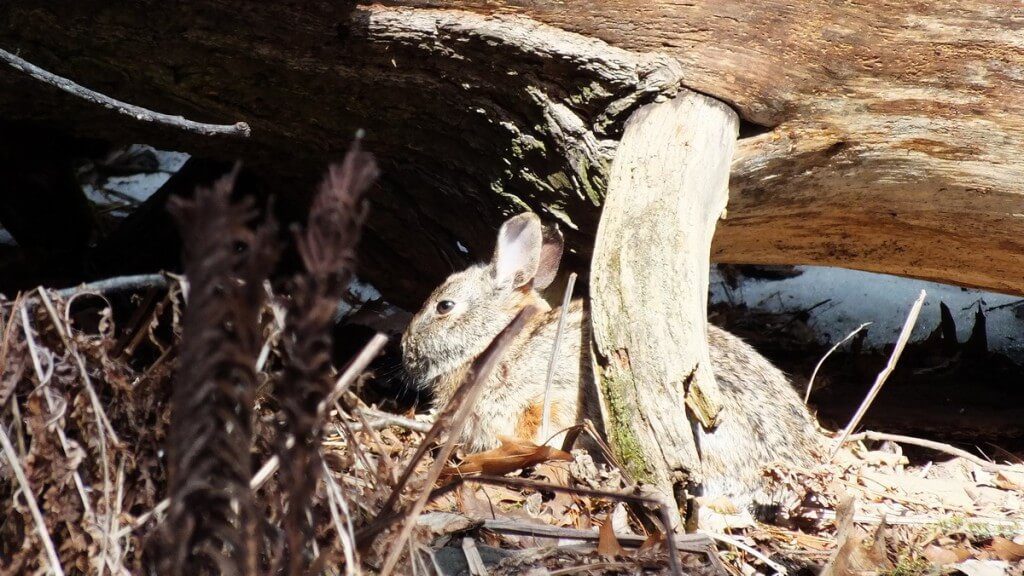
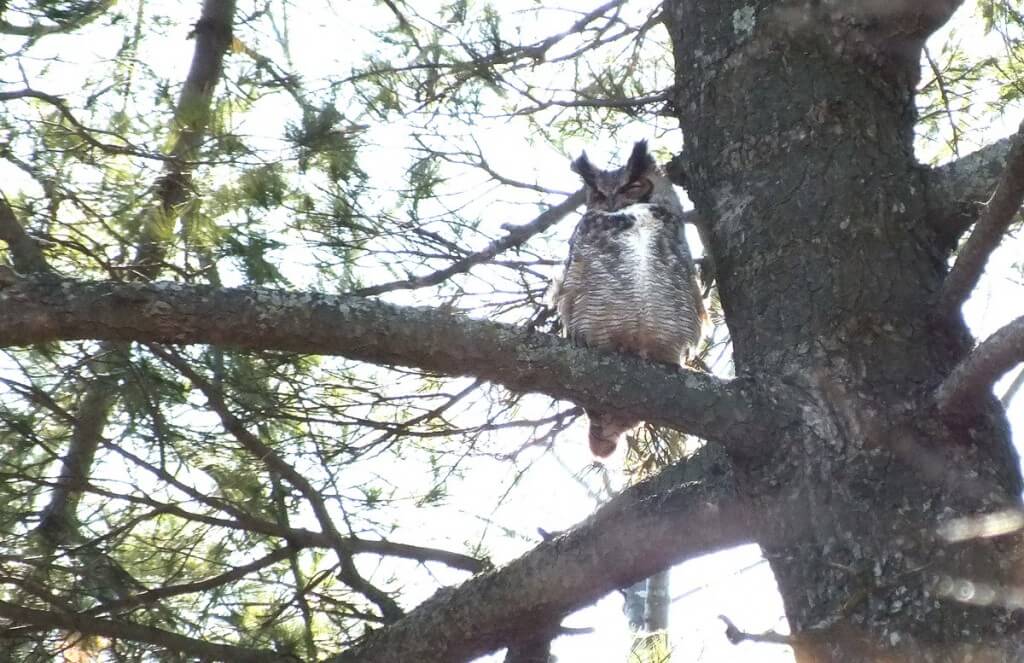
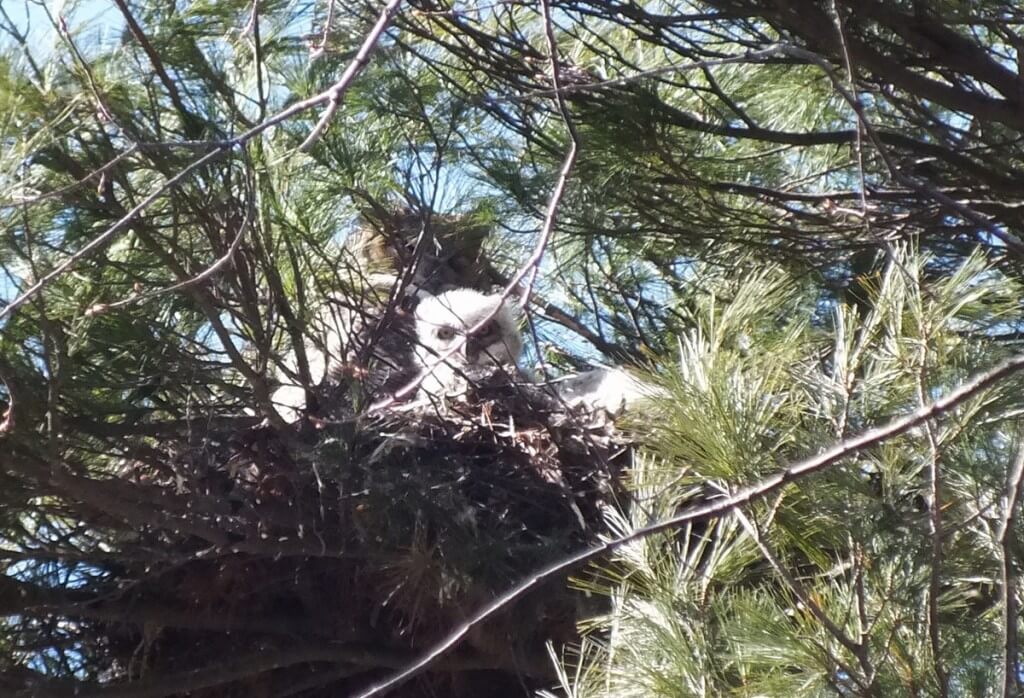
what camera do you shoot with?
Hi Wendy. Thanks for checking out our blog about the Great Horned Owl chicks. I shoot with a Fujifilm HS20 EXR that has a 30x zoom lens, which covers a 35mm equivalent focal range of 24-720mm. The pictures you see were shot with this lens. We have just added a new lens to our equipment, a Raynox lens, Model DCR-2025PRO 2.2x telephoto lens. I am anxious to try it out. My husband shoots with a Sony professional video camera.
I too have had the great delight to go and see this owl family. It is truly a wonderful sight. I have been watching another nest in the City of Kawartha Lakes area and everyday check on it to see if the owlets are big enough for me to see in the nest When my husband and I were in the Thickson Woods we took great delight in inspecting the pellets below the tree where the male sits.
That’s a good suggestion. Bob and I haven’t bothered to check out the pellets below the male’s perch and must do so when next we visit the woods. Thanks for giving me the idea.
Let me know what you find, we found tiny bones and a skull. I am going on the weekend to see how they are growing. Take care happy birding
Will do. It should be very interesting. Could you identify the skull?
do you know why they are bobbing? I believe it is to help them focus in on a subject. I have been watching a web cam of a family of Great Horned owls and the information is the best. http://www.ustream.tv/okcowlcam?utm_source=crowd-live-backend&utm_medium=visit-channel-ustre-am&utm_campaign=notifications. have a look
Bobbing may have more to do with hearing. Owls hear asymmetrically, meaning one ear is higher than the other. Bobbing could be a way of hearing the sound more uniformly. Being nocturnal hunters, they will depend on sound more than sight.
Thanks for your insight. You may well be right. I have to do some research into this characteristic action of the baby owls.
I have no idea why the owlets perform the bobbing action, but I see that another subscriber has provided some insight into the matter. I took a look at the webcam of the Great Horned Owls. I love being like a fly on the wall – spying on them. Thanks for the link.
The great horned owl and the great grey owl will only compete over finding a nest, but not in finding food. The great horned owl will eat anything it can overpower, while the great grey owl will feed on voles. That rabbit can end up as a meal for a great horned owl, and that marshland could be providing fish, frogs, and garter snakes for a great horned owl’s meal. Also, what is different is the way they raise their young. With the great horned owl it will be just the parents, while with the great grey owls, the older siblings from the previous brood, will help raise their younger brothers and sisters.
Thanks for the additional information. We know that Long-Eared Owls have also been sighted in Thickson’s Woods, although Bob and I have yet to see either of them.
Long-eared owls are generalists too, just like the great horned owls. But they demand thick groves of forests, and thinning of forests will drive them out. It is not known if great horned owls will prey upon them, but great horned owls will definitely prey upon barn and screech owls. Much of of the habits of long-eared owls still is not known.
Amazing pictures and video. You must really know what you are looking at, to get some fantastic shots. That one chick seems to be as interested in you as you are in him/her. Thank you so much for sharing.
Thanks, Bonnie. There were different moments, when watching the chicks, when I just had to laugh. The one was bobbing up and down, to the left and then to the right, over and over again. It was quite cute!